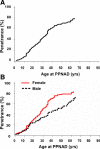Mutations in regulatory subunit type 1A of cyclic adenosine 5'-monophosphate-dependent protein kinase (PRKAR1A): phenotype analysis in 353 patients and 80 different genotypes
- PMID: 19293268
- PMCID: PMC2690418
- DOI: 10.1210/jc.2008-2333
Mutations in regulatory subunit type 1A of cyclic adenosine 5'-monophosphate-dependent protein kinase (PRKAR1A): phenotype analysis in 353 patients and 80 different genotypes
Abstract
Background: The "complex of myxomas, spotty skin pigmentation, and endocrine overactivity," or "Carney complex" (CNC), is caused by inactivating mutations of the regulatory subunit type 1A of the cAMP-dependent protein kinase (PRKAR1A) gene and as yet unknown defect(s) in other gene(s). Delineation of a genotype-phenotype correlation for CNC patients is essential for understanding PRKAR1A function and providing counseling and preventive care.
Methods: A transatlantic consortium studied the molecular genotype and clinical phenotype of 353 patients (221 females and 132 males, age 34 +/- 19 yr) who carried a germline PRKAR1A mutation or were diagnosed with CNC and/or primary pigmented nodular adrenocortical disease.
Results: A total of 258 patients (73%) carried 80 different PRKAR1A mutations; 114 (62%) of the index cases had a PRKAR1A mutation. Most PRKAR1A mutations (82%) led to lack of detectable mutant protein (nonexpressed mutations) because of nonsense mRNA mediated decay. Patients with a PRKAR1A mutation were more likely to have pigmented skin lesions, myxomas, and thyroid and gonadal tumors; they also presented earlier with these tumors. Primary pigmented nodular adrenocortical disease occurred earlier, was more frequent in females, and was the only manifestation of CNC with a gender predilection. Mutations located in exons were more often associated with acromegaly, myxomas, lentigines, and schwannomas, whereas the frequent c.491-492delTG mutation was commonly associated with lentigines, cardiac myxomas, and thyroid tumors. Overall, nonexpressed PRKAR1A mutations were associated with less severe disease.
Conclusion: CNC is genetically and clinically heterogeneous. Certain tumors are more frequent, with specific mutations providing some genotype-phenotype correlation for PRKAR1A mutations.
Figures



References
-
- Michels VV 1986 A new inherited syndrome with cardiac, cutaneous, and endocrine involvement. Mayo Clin Proc 61:224–225 - PubMed
-
- Carney JA, Gordon H, Carpenter PC, Shenoy BV, Go VL 1985 The complex of myxomas, spotty pigmentation, and endocrine overactivity. Medicine (Baltimore) 64:270–283 - PubMed
-
- Boikos SA, Stratakis CA 2007 Carney complex: the first 20 years. Curr Opin Oncol 19:24–29 - PubMed
-
- Carney JA 1995 Carney complex: the complex of myxomas, spotty pigmentation, endocrine overactivity, and schwannomas. Semin Dermatol 14:90–98 - PubMed
Publication types
MeSH terms
Substances
Grants and funding
LinkOut - more resources
Full Text Sources
Other Literature Sources
Medical
Molecular Biology Databases

